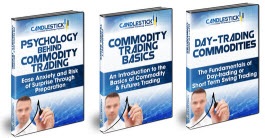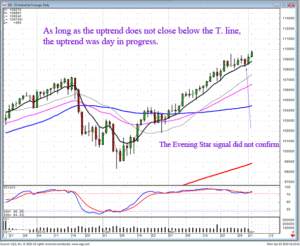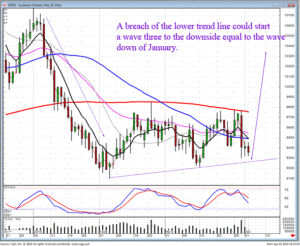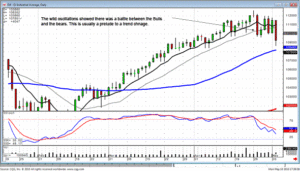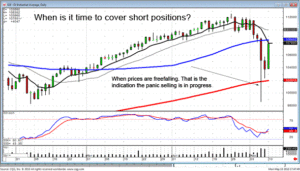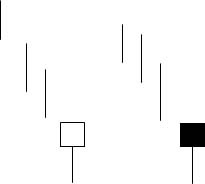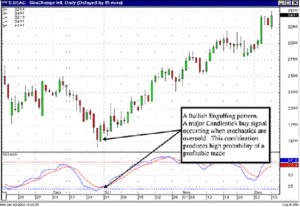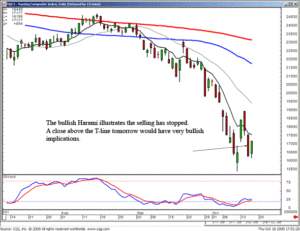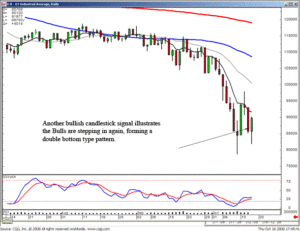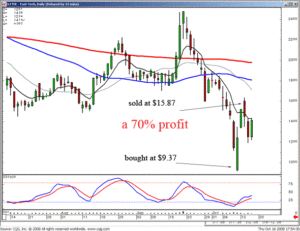Fundamental commodity analysis is how traders understand the big picture. It is how they maintain a sense of perspective in commodities markets. Commodity prices fluctuate in the short term based on technical trading analysis. Long term commodity trading is much more heavily based upon fundamental analysis of the commodities markets. Fundamental commodity analysis comes down to two factors, supply and demand in commodity trading. Commodities and Futures Training can be a great help in developing effective strategies for trading on a commodities exchange.
The commodity futures market is different for crops and livestock than it is for durable commodities such as gold. Commodities trading in each can be profitable but it is important for commodities traders to understand the differences in supply and demand for these two types of commodities. Here we look at crops and livestock.
Commodity supply can be influenced by a large number of factors. Supply factors are different for trading agricultural commodities as opposed to the commodity market in precious metals, for example. Food can be stored dry or refrigerated but eventually needs to be consumed. Food is, in fact, produced to be eaten. Therefore the supply of crops and livestock needs to be replenished every growing season. This makes food commodities susceptible to short term factors such as the weather in different parts of the globe. It also makes food supply dependent upon adequate storage as well as transportation from producing areas to the consumer. Fundamental commodity analysis of these factors will improve the chances of success in trading commodities.
The amount of crops planted, the amount not consumed last year, crop disease, weather, anything that stops food from arriving at the table, and technology. Low supply leads to higher commodity prices and higher prices lead to more production and higher supply. Higher supply leads to lower prices and reduced production and then the cycle repeats itself. Commodity investing will be more successful if the trader understands the factors that increase and decrease food production and availability of the commodity. The so called Green Revolution that increased crop yields not only fed millions more but it helped keep each grain commodity price within reasonable limits. An understanding of genetic engineering and crop yields is an excellent example of fundamental commodity analysis.
Fundamental commodity analysis starts with supply but supply is inextricably tied to demand. Absolutely sufficient supply related to demand would mean that commodity prices would stay absolutely fixed, year after year. Commodity trading charts would just show a flat line extending into the future. Commodity trading software would not be needed and, in fact, food would not be a trading commodity. With a growing world population and more affluent societies in Asia demanding more protein rich food the demand for livestock has gone up and grains are diverted into cattle feed instead of being sent to the table. Understanding the changing dietary patterns of much of the developing world is part of fundamental commodity analysis. Good commodities tips may have as much to do with what Chinese teenagers want to eat as with how much land is planted in Argentina, Brazil, the United States, Canada, and the Ukraine.
Why is it dangerous to listen to one person’s fundamental analysis? Everybody has an outlook on what should be occurring in the future. Unfortunately, when one person evaluates the likelihood of events for the future, it is based upon the information made available to them. It also involves factors in their thinking process. That process may over emphasize or under emphasize elements that could affect the movement of future prices. Where one analyst may view information in a positive perspective, another analyst they look at the same information with a negative perspective. This makes relying upon one person’s analytical view as a very high risk investment strategy. Even Warren Buffett has had huge losses in specific sectors or currencies in the past.
What makes for a successful analytical view? The overall market! The best way to take advantage of everybody’s fundamental analysis is analyze the technical moves of a market. This is the accumulative knowledge about everybody analyzing a specific trading entity and acting upon that analysis. Candlestick signals provide the clearest form of visual analysis of how a total market has been analyzed. What is fundamental analysis? It is the evaluation of what future price moves should do based upon the current knowledge available and anticipation of future factors. Candlestick signals and patterns identify what the majority of investor sentiment is conveying. This is not rocket science! This is letting the market tell you what the market is doing.
Candlestick signals illustrate the temperament of investors. As witnessed in the Dow over the past few trading days, there was an indication the Bulls may be running out of steam. Was this the time to sell? The Bearish Harami, followed by a Shooting Star Doji and another Doji would indicate the possibility investment sentiment was losing its bullish force. However, one simple element has not occurred. Confirmation! Indecisive signals require confirmation. Otherwise, unless it can be confirmed the Bears were taking control, the uptrend has to be considered to still be in progress. What is one of the simple rules that allows candlestick investor’s to keep from being scared of the market? An uptrend requires selling confirmation to indicate it is time to take profits. Selling confirmation, in these market conditions, would require a candlestick sell signal followed by a close below the T. line. Today’s positive trading was an indication the market may have merely been resting, waiting for the T. line to catch up.
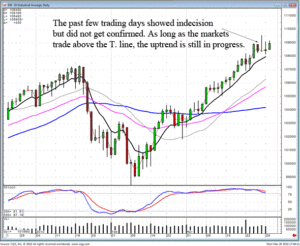
DOW
The simple rules applied the candlestick analysis are merely common sense. Candlesticks, utilized correctly, are very instructive for indicating when it is time to buy, time to hold, and then time to sell. If you are a beginning investor, learning candlestick analysis first would keep a lot of confusing misinformation from screwing up investors thought processes. Successful investing requires understanding what makes prices move as they do. It is often professed in the Candlestick Forum chat room’s that prices do not move based upon fundamentals, they move upon the perception of fundamentals. Teach this to your kids! They will have a much better understanding of how to invest their funds successfully.
When it becomes clear that prices move in reoccurring patterns, that is when an investor will be able to consistently produce profits from the markets. Unless you have unlimited resources and capabilities to follow many stocks, or factors that would influence trading entities such as commodities and currencies, candlestick analysis becomes the best format for taking advantage of factors that will influence specific price moves. Candlestick patterns illustrate the reoccurring investors thought processes that can produce very strong profits. As illustrated in the APL chart, the potential of a big price gain is based upon witnessing a scoop pattern in progress.

APL
Knowing what the result of a pattern can produce allows an investor to put their funds to work in the best potential situations. The purpose of investing is to have your funds in high probability/high profit situations. This implies placing funds in situations with big upside potential yet a limited downside risk. Analyzing stock or commodity positions based upon the information built into candlestick signals allows for low risk situations. The ability to analyze market trends, or other trading entities that will influence the price movement of what you were trading, is a huge advantage. This ability is made very easy using the visual aspects of the candlestick signals.
Chat session tonight at 8 pm ET
Good Investing,
The Candlestick Forum Team
New Training Tutorials
Commodity & Futures Trading
Promotional pricing
25% Off for the next 3 days!
Website special reflects current newsletter. If you are reading an archived newsletter you will be directed to Current Website Special.

